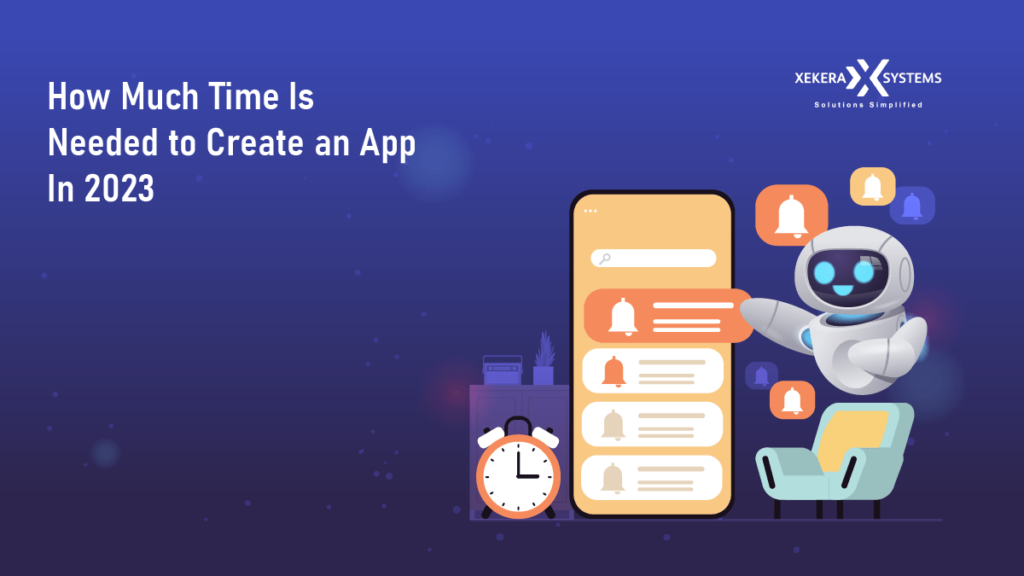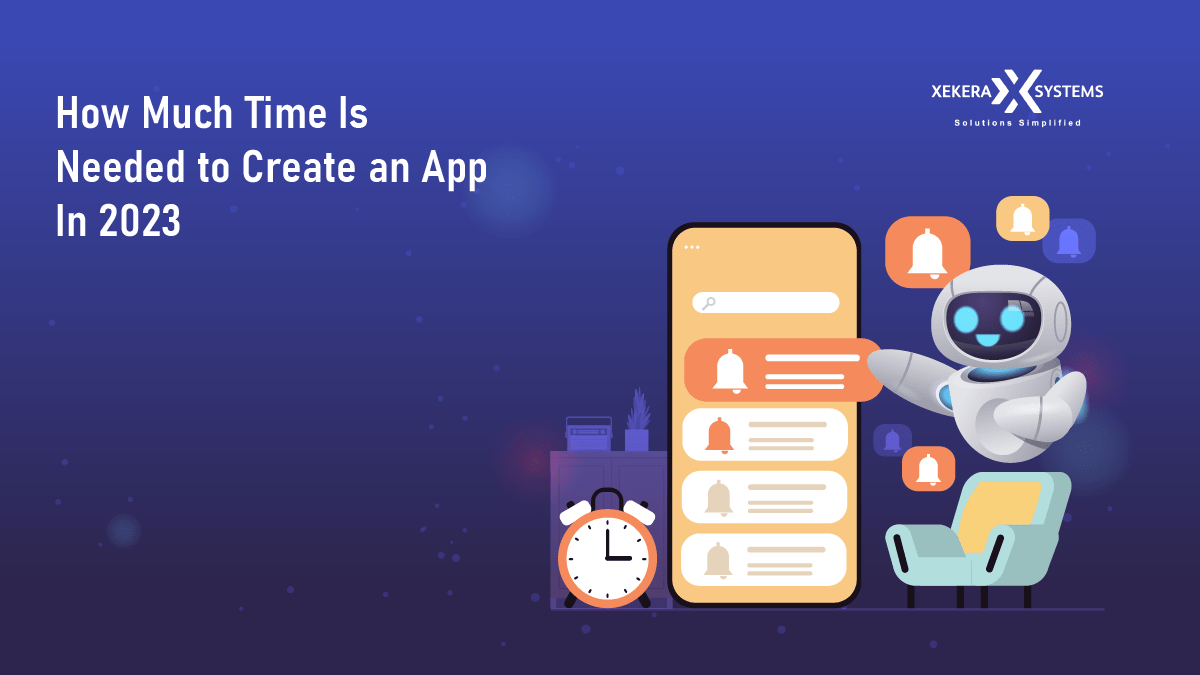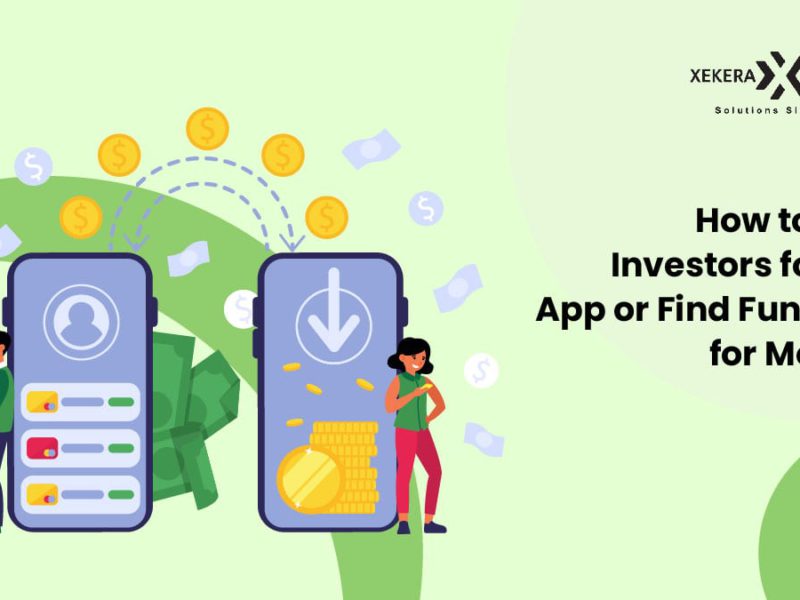Nowadays, practically every business needs have a mobile application. They are conscious that it is essential to present themselves in digital form in this cutthroat day where the majority of people spend a significant amount of time on mobile. And that’s where the creation of mobile applications comes in! And people would be interested in learning how long it takes to submit an application.

When individuals take the initiative to create an app from scratch, a problem occurs. Since the entire ecosystem of app development is foreign to the majority of them. They are unaware of the price and the technology. They are completely unaware of the project’s schedule for developing mobile applications.
For the past ten years, we have worked on app development projects with a variety of enterprises. On their initial conversation, 8 out of 10 clients inquire about the project completion time and application development cost.
Additionally, we have encountered numerous complexities in projects, which frequently take the shape of delays and client-side last-minute add-ons. Late adjustments ultimately result in higher project expenses for the clients because they increase the complexity of application development and add to project completion time. On the other hand, other clients had always been clear about what they wanted and had experienced a timely, cost-effective completion of their final project.
Keeping these factors in mind, we made the decision to publish an extensive article that covers the typical time required for app development as well as tips for cutting project duration without sacrificing application quality. This tutorial on how long does it take to produce an app might be very helpful for any company or startup that is embarking on a path of digitising their business but is unaware of the application development process.
Let’s Get started!
How Long Does it Take to Make an App
We are aware that every software is distinctive in some way. The question of how long it takes to create an app has no clear-cut solution. Additionally, the various stages of the mobile app development process are segmented based on the needs of the app.
Some applications have been finished in just four weeks. Due to the complicated features or other challenges that happened during the projects, several applications took 12 to 18 weeks to complete. It typically relies on the kind of software and the amount of experience the development team has.
One thing you must keep in mind, though, is that the price of your mobile app is directly correlated with the amount of time it takes to produce one (because you are investing your hard-earned money!).
Hence, carefully examining each stage of app development and the duration of an app’s launch. The stages of the mobile application that contribute the most time are listed below.
Time Taken In Mobile App Planning (2-3 weeks)
So you have an app idea and have located the ideal partner for development. What’s next?
You need to give your idea for a mobile app some thought. Your developers will be able to comprehend your users, specify business objectives, and choose needs as they construct the programme. It takes time to prepare the ideal brief for mobile app development since you need to communicate your idea and vision for the app to the developer.
What Should be Included in brief?
- What kind of application, its user base, and how you want it to be developed
- A complete project description in which you give app idea in detail. Are you selling a product or service? Type of product or service. Whether you are promoting something or enhancing the target audience’s loyalty. Everything should be discussed.
- The description of the end-user- who they are, how they make decisions, and what are their penchant towards.
- If you have a familiarity with platforms, then your preferred choice of platform. (iOS vs Android development or both). Native or Cross-platform. Native apps are more efficient and provide more usability. But if you want to develop your mobile application as soon as possible, then Cross-platform is the best choice. You could also ask your developer about it.
- If you know about backend, then explain your preferred communication protocol, security preferences, data storage, offline mode, and more. You could also get help from our developers.
- Give briefings about the design you want. What you have researched and what kind of design you want.
Therefore, meticulous research into every desired element is required when preparing for mobile devices. Planning a mobile app takes about two to three weeks.
Be sure to involve your development partner in this process so they can offer you greater advice on how to create a seamless mobile application.
Design Sprints (2-3 weeks)
What is the length of time for designing an application?
As soon as you give your app development project the all-clear, your app development business gets to work on the design phase. Now, the length of time it takes to construct a mobile app design depends on how sophisticated the design is.
It can take less time if you’ve given designers a general notion of the design and are clear on that. On the other hand, if designers must start from scratch and brainstorm ideas, this process could take many additional weeks.
Typically, designers start with flow control and structures before focusing on the look and feel of the mobile application. At this point, they begin wireframing. It aids in their comprehension of the number of displays and how users will navigate around the app.
While some designers believe in using technologies like Sketch or Adobe XD, the majority of designers prefer pen and paper for creating initial designs. They finish wireframing the app in 3 to 4 days.
The design process advances once these wireframes are given to developers and clients for approval. Prototypes and mockups are created here. At this stage, designers create the app’s icons, backgrounds, buttons, logos, and font.
Collaboration with Developers
Working with developers is one of the most important things designers do while building app designs. To avoid development complications is the justification. Redesigning the screen may take more time if the designers’ designs are not technically feasible to implement at the development side. The extravagant design of the app is incompatible with all devices and operating systems.
Designers then turn over the entirety of their work to developers for further development.
Keep in mind that the intricacy of the design, the number of devices (including phones and tablets), and the number of screens an app has all affect how long it takes to develop.
So complete app designing takes 2-3 weeks.
Development (12-14 weeks)
The development stage is one of the longest but most crucial steps in the creation of an app. The success of any app is largely dependent on its flawless coding. And before beginning the coding, a flawless planning and timeframe should be discussed in order to have that error-free code.
For instance, we are developing an agile process to deliver the software early and predictably. We can adjust when it’s essential for a better flow, which saves time.
Typically, developers work on “Sprints” or “Milestones.” They split the tasks into their own areas of competence and get to work.
Backend developers and frontend developers make up the development portion. Let’s examine the next steps in the development process to determine how long it takes to create an application.
Backend Development
Storage of data: Typically, development firms start at the database level and move forward. They initially determine how much of the application’s data they believe they will require.
User Management: At this level, user authentication and data storage API development is underway. In a nutshell, this article addresses the user registration process, authentication, and password management.
Server-side logic: It shows the application server’s flows and how it handles user requests that come from the user interface.
Data Integration: Developers carry out procedures and logic to gather, modify, and distribute data from various sources across one or more data locations.
Push Notification: The task of sending alerts from the server to the user’s device has been completed. (For example, a message that a product has been added to your preferred store). Keep in mind that not every app needs this feature.
Versioning: It allows the back end developers to work on a new version without disturbing the existing one.
The front end development has already begun as back end developers continue to code and build the technologies. The total timetable for the creation of mobile applications is being shortened as a result of front end development not beginning before back end work. We’ll learn why development firms favour starting with the backend initially. But first, let’s look at how long the frontend of the app takes to make and what goes into it.
Be sure to check the milestone you’ve agreed upon and inquire about how the backend functions when working with any company or developer.
Front End Development:
The development team begins working concurrently on the front end of the mobile application after the server is developed and the database structure is established. It will be using the aforementioned back-end server to render and create data.
The tasks that enable functionality are typically managed by the front-end developers between 6 and 8 weeks. Programmers use platforms like Swift, Objective-C, and Java to build distinct App Store and Google Play versions.
It’s crucial to understand that the front-end development and UI design portions of the project involve a lot of repetitions, as we saw in the design segment. The team should be ready for a lot of conversations and adjustments because the design and fluidity of the interface are far more individualised than even UX design.
Caching is developed for temporary data storage in the frontend. In order to speed up the application’s loading time and avoid accessing the server, the application’s data is essentially kept in caching.
Developers create a data synchronisation mechanism to enable the programme to run offline. To store updated data sets, it keeps track of the versions of the data created both online and offline.
In addition, the frontend component undergoes internal testing to guarantee that everything is flawless and operating as intended.
Typically, the frontend development cycle takes six weeks to finish.
Testing (3 weeks to 4 weeks)
The final and most crucial phase of the application development process begins once the developer side of development is complete.
Yes, testing is the process of identifying flaws and problems that, if left unchecked, could compromise the functionality of your programme.
Quality analysts typically work on this procedure to ensure that your software is filtered and fully functional when it is finished. Before moving on to the next step, QA focuses on initial testing known as “Alpha testing” to eliminate some fundamental flaws and complexity. The application is typically tested to see if it functions as intended or not. Whether or whether the app’s functioning supports the intended design To enter the market, this kind of testing is insufficient.
In the majority of projects, our quality analyst determines the need for the application and develops test cases that developers can refer to as they begin work on the programme. As a result, early on in the creation of the app, some fundamental features and functionality were corrected. Then, our testers focus on functionality and user interface testing. They fix the issues one module at a time.
Verifying the app’s compatibility is one of the testing process’ most important steps. due to the fact that some programmes are multi-device compatible. In order to provide improved compatibility and a seamless user experience, it was thoroughly tested on all main devices. Finally, our QA team tests the application’s performance.
The app is put through beta testing and made accessible to a small number of users before it is finally released in full. The mobile app undergoes final testing to fix any remaining issues before being uploaded to app stores for general use.
Application testing typically takes three to four weeks during the creation of a mobile app.
Deploying to The App Store (Up to 1 Weeks)
You have now created an application. Additionally, you’ve finished the testing process. What’s next? How long does it take to release an app to the market?
However, do you believe that your software will go live on the app stores without any issues? No. For doing it, there is no immediate approval procedure. So what do you need to do?
To present your application to people in the app stores, you must do a number of procedures.
If you want your software to be published in the Apple App Store, you must adhere to their tight rules. And doing it requires a substantial amount of time. To access the Android Playstore, you should abide by some regulations as well.
How long does it take for an application to appear in app stores?
Your app is evaluated by both well-known shops in accordance with their review guidelines.
- Apple App Store
Apple is renowned for having more stringent submission guidelines. reviews about the app’s security, as well as comments on its functioning, content, and design. Apple doesn’t want its app store to be overrun by unprotected, low-quality, and bug-ridden applications.
Therefore, be sure to submit your application to the App Store only after carefully reviewing all the requirements. You may read Apple’s development guidelines for apps.
Your iOS app’s approval time in the app store is dependent on a number of variables. Do not lose your cool if the app is refused; instead, politely contact Apple’s Resolution Center. They would provide a justification for rejecting you.
The average turnaround time for apps we’ve submitted to the Apple store is two days, maybe a bit more. However, it depends on the kind of app you have.
Over 90% of mobile apps are evaluated in 48 hours and 50% are reviewed in 24 hours on average in the Apple Store.
- Google Play Store
Regarding the Google Play Store, it too has standards for quality. If you don’t want your application to be denied, you should adhere to it strictly. It will also prolong the completion date of your project.
Recognize that Google wants your app to be launched quickly and easily; after all, they profit from the sale of your app. Therefore, it is better to publish your app after reviewing each policy that Google wants you to abide by.
According to the most recent Play store rule, it will typically take a minimum of 3 days to submit your application and go live if you are authorising your app for the first time.
However, if you update a second or third programme through the Google Play store, it will do so the same day, in fact, within two hours.
How to Shorten the App Development Timeline
As we’ve already covered, the cost of an app increases with the amount of time spent developing it for mobile devices.
People frequently ask us how to create an app for their company quickly. If you want to quickly launch your application and enter the market before someone else steals your idea. You need to examine numerous strategies for developing your mobile application in a lot less time.
Let’s clarify that and learn how to shorten the time it takes to develop a mobile app.
Go for Cross Platform
Another strategy, called cross-platform app development, has the potential to significantly reduce the overall time required for app development.
Given that the native software was created specifically for the target platform (i.e iOS and Android). As a result, two different apps and separate coders are needed to reach a wider audience. Thus, the time required to design an app is longer.
Contrarily, cross-platform development enables developers to create an app once and use it across both platforms. Nearly all of the code is interchangeable and identical. As a result, you may create an application more quickly without sacrificing user experience. In addition, unlike Native, where you can only upload your programme to app stores, you can advertise your software across a variety of channels.
The preference for these platforms has increased since since software titans like Google and Facebook developed their cross-platform technologies, dubbed Flutter and React Native, respectively.
In conclusion, if you want your application to hit the market as fast as feasible, choose cross-platform development.
White Label Solution of Clone Apps
It wouldn’t be an exaggeration to state that any successful software gets imitated in droves due to factors like lower cost, time, and skill requirements.
You may quickly obtain an application that is comparable to well-known apps on the market with these white-label clone apps in around a week. In these services, the application’s data layer stays the same, but the front end can be changed. The application’s user interface (UI) can be modified to suit your preferences. In essence, you get a ready-to-use app that you can brand with your own logo.
There are several companies that produce clone applications and offer white label solutions; they may give you clones of popular apps like Uber, Netflix, TaskRabbit, Uber Eats, and others.
Typically, some business owners favour these types of solutions since they can be acquired more quickly and inexpensively. They are aware that creating a custom application could take a long time. But these are the very reasons you SHOULD NOT work with a low-cost mobile app development firm.
White-label apps may therefore be the best choice to shorten the time required for application development.
In addition to these strategies, make sure you are crystal clear when you are early on discussing your project with the developers. Because the development process would be disrupted and the development time for the app would be extended by any late additions of the various functions.
Conclusion
What is the time frame for creating an app? Well, there are several variables described above that affect the answer to this question. The process of creating an app is complicated. While some sophisticated apps may take 5–7 months to develop, some basic apps can be created in as little as 2 months. Applications that are more complex will have more features and functionality. The design will also be more intricate and sophisticated.
However, there are several ways to launch your ideal startup much more quickly, such as by creating an cross-platform application, or a white label clone application.
Do you have any app ideas that you would want to see implemented? Let us design the most attractive and marketable mobile application for you within a predetermined timeframe to assist you.
Alternately, you can employ specialized developers to work just on the creation of your mobile application, Contact us.
Frequently Asked Questions (FAQs)
Q 1. How do I create a timeline for an application?
The process of creating a mobile app consists of several steps, each of which takes a few weeks to complete. The process of launching a flawless, high-quality application takes a lot of work from developers. Each stage is completed in about a few weeks, as seen below:
- Idea Formulation and Research (2-3 weeks)
- Specifications and Design (2-3 weeks)
- App Architecture and Development (12-14 weeks)
- Testing and Finalizing (3-4 weeks)
- Deployment- upto 1 week
Q 2. How long does it take to develop an app in hours?
Including all the stages of application development, creating a mobile application would take roughly 250–300 hours. Additionally, it will take a minimum of three days from submission to become live for an app to be deployed on the store and receive approval. Everything is dependent on the kind of application.



